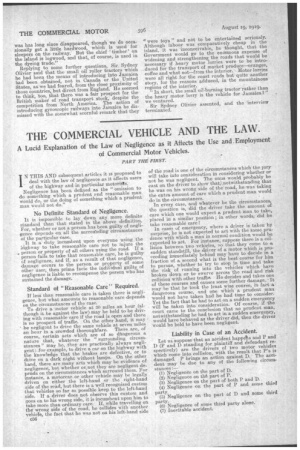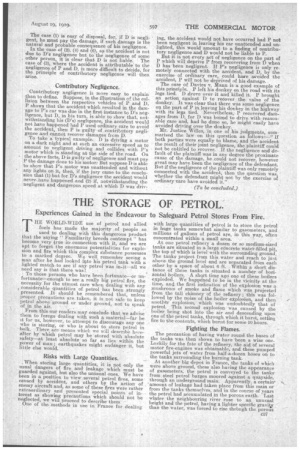THE COMMERCIAL VEHICLE AND THE LAW.
Page 14

Page 15

If you've noticed an error in this article please click here to report it so we can fix it.
A Lucid Explanation of the Law of Negligence as it Affects the Use and. Employment of Commercial Motor Vehicles.
PART TIlE FIRST.
IN THIS AND subsequent articles it is proposed to .. deal with the law of negligence as it affects users of the highway and in particular motorigts. Negligence has been defined as the "omission to do something which a prudent and reasonable man would do, or the doing of something which a prudent man would not do."
No Definite Standard of Negligence.
It is impossible to lay down any more definite standard than that stated in the above definition. For, whether or not a person has been guilty of negligence depends en all the surrounding Circumstances of the particular ease. It is a duty incumbent upon everyone using the highway to take reasonable care not to injure the * person or property of all others using the road. If 'a person fails to take that reasonable care, he is guilty of negligence, and if, as a result of that negligence, damage occurs to the person or property of some other user, then prima facie the individual guilty of negligence is liable to recompense the person who has sustained the damage.
Standard of "Reasonable Care" Required.
If less than reasonable care is taken there is negligence, but what amounts to reasonable care depends on the circumstances of the case.
To drive a .motor vehicle at 30 miles an hour (al, though it be against the law) may be held to be driving with reasonable care if the road is open and there is no prospect of traffic. On the other hand, it may , ' be negligent to drive the same vehicle at seven miles an hour in a crowded thoroughfare. There are, of course, certain acts which are of so dangerous a nature that, whatever the "surrounding circumstances" may be, they are practically always negligent : -for example, to drive a car on the highway with the knowledge that the brakes are defective, or to diive on a dark night without lamps. On the other hand, there are many acts which may be evidence of negligence, but whether or not they are negligent depends on the circumstances which surround them. For instance, a motorcar. or other vehicle may be legally driven on either the left-hand or the right-hand side of the read, but there is a well recognized custom that vehicles so far as possible keep to the left-hand .side. If a driver does not observe this custom and goes on to his wrong side, it is incumbent upon him to take more than ordinary care. If, while travelling on the wrong side of the road, he collides with another vehicle, the fact that he was not on his left-hand side
036
of the road is one of the circumstances which the jury will take into consideration in considering whether or not he was negligent. The onus would probably be cast on the driver to show that,. notwithstanding that he was on his wrong side of -the road, he was taking the extra amount of care which a prudent man would do in the circumstances.
In every case, and whatever be the circumstances, the question is, did the driver take the amount of care which one would expect a prudent man to take, placed in a similar position ; in other words, did he take reasonable care ?
In cases of emergency, where a driver is taken by surprise, he is not expected to act with the same prudence with which a man in normal condition would be expected to act, For instance, suppose there is a collision between two vehicles, SO that they come to a sudden standstill, the driver of a motor which is proeeeding immediately behind may have to decide in a fraction of a second what is the best course for him to pursue, whether to try to atop in time and take the risk of running into the vehicles which have, broken down or to swerve across the road and risk collision with other traffic". He decides and takes one of these courses and causes some further damage. -It may be that he took the least wise course in fact a dangerous course, and one which a prudent man would not have taken had he had time to consider. Yet the fact that he had to act on a sudden emergency will be taken into consideration. Of course, if the court came to the conclusion that no prudent man, notwithstanding he had to act in a sudden emergency, would have behaved as the driver did, then the driver would be held to have been negligent.
Liability in Case of an Accident.
Let us suppose that an aocident happets and P and D (P and D standing for plaintiff and defendant respectively) are the drivers of two motor vehicles which come into collision, with the result that P's is damaged. P brings an action against D. The accident may be due to any of the following circumstances :— (1) Negligence on the part of D. (2) Negligence on th6 part of P. (3) Negligence on the part of both P and D. (4) Negligence on the part of P and some third party. (5) Negligence on the part of D and some third party.
(6) Negligence of some third party alone. (7)' Inevitable accident.
The ease (1) is easy of disposal, for, if D is negligent, he must pay the damage, if such damage is the natural and probable consequence of his negligence.
In the case of (2), (4.) and (6), as the accident is not due to D's negligence but to the negligence of some other person, it is clear that D is not liable. The case of (3), where the accident is attributable to the negligence of P and D, is more difficult to decide, for the principle of contributory negligence will then arise.
• Contributory Negligence.
Contributory negligence is more easy to explain than to define. Suppose, in the illustration of the collision between the respective vehicles of P and D, P shows that the accident which resulted in the damage to P's car was due in the first instance to D's negligence, but D, in his turn, is able to show that, notwithstanding his (D's) negligence, the accident would not have happened had P used ordinary care to avoid the accident then P is guilty of contributory negligence and cannot recover damages from D. To take a typical example. D is driNing a motor on a dark night and at such an excessive speed as to amount to negligent driving and collides with P's motor which is standing at the side of the road. On the above facts, D is guilty of negligence and must pay P the damage done to his motor: But suppose D is able to show that P's motor was unattended and without any lights on it, then, if the jury came to the conclusion that (1) but for D's negligence the accident would nevee,have happened and (2) if, notwithstanding the negligent and clangerpus speed at which D was-diriv
ing, the accident would not have Occurred had P not been negligent in leaving his car unattended and unlighted, this would amount to a, finding of eontributory negligence and D would not be liable to P.
But it is not every act of negligence on the part of P which will deprive P from recovering from D when D has been negligent. If P's negligence is only remotely connected with the accident, and D, by the exercise of ordinary care, could have avoided the accident, P will not be deprived of his damage. The case of Davies v. Mann is a good example of this principle. P left his donkey on the road with its legs tied. D drove over it and killed it. P brought an action against D to recover the value of the donkey. It was clear that there was some negligence on the part of P in leaving his donkey in the highway with its legs tied. Nevertheless, P recovered darnages from D, for D was bound to drive with reasonable care and, had be done BO, he might -easily have avoided driving over the donkey. Mr, Justice Willes, in one of his judgments, summarised the law on this question as follows:—" if both parties were equally to blame, and the accident the result of their joint negligence, the plaintiff could not be entitled to recover. If the negligence and default of the plaintiff was in any degree the proximate cause of the damage, he could not recover, however great may have been the negligence of the defendant. But if the negligence of the plaintiff was only remotely connected with the accident, then the question was, whether the defendant might not by the exercise of ordinary tare have avoided it."
(Po be concluded.)






















